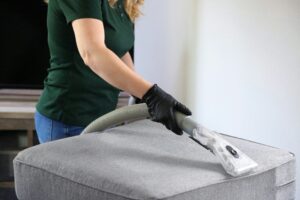Summer heat may be uncomfortable for many people, but it can also majorly affect indoor air quality. High temperatures can change the air, and knowing how it impacts your health is the first step in taking action to improve it. Fortunately, there are several ways to enhance the quality of air. By making simple adjustments to your home, you can create a cleaner, safer environment for everyone.
How Heat Affects Indoor Air Quality
Extreme heat affects indoor air quality in several ways:
- Increased pollutants: High temperatures can increase pollutants and keep them in the air, especially if it’s stagnant. Even if you run AC, pollutants can increase from cooking, cleaning and other activities, leading to high levels of harmful substances like volatile organic compounds (VOCs) and carbon dioxide.
- Outdoor air infiltration: During hot weather, outdoor pollutants such as pollen, dust and smog can easily infiltrate your home. Outdoor pollutants are especially problematic in urban areas with high traffic and industrial activity levels.
- Heat-related off-gassing: Many household items — including furniture, carpets and paints — release more chemicals into the air when exposed to high temperatures. Off-gassing increases the concentration of indoor pollutants, which can cause health complications.
According to the Environmental Protection Agency (EPA), Americans spend 90% of their time indoors. As the outdoor temperatures increase, you’re even more likely to stay inside. As a result, poor indoor air quality increases and can be detrimental to your health. It can cause headaches, dizziness and respiratory irritation. These symptoms are more likely to occur if you suffer from certain medical conditions like asthma.
Improving Indoor Air Quality
While you have zero control over the summer heat, you can implement several measures to keep your home safe.
1. Maintain Proper Ventilation
Good ventilation is key to removing stale air and diluting indoor pollutants like mold and allergens. One way to achieve this is by using exhaust fans in areas like the kitchen and bathroom. Rooms with high humidity and pollutants are critical places for fans to expel excess moisture and contaminants. Plus, they’ll work to prevent mold and mildew from building up in the first place.
Another tactic that works is periodically opening windows and doors to allow fresh air to circulate throughout your home. This method works especially well in the morning or late evening when temperatures are cooler. It can reduce the concentration of indoor pollutants and improve the overall air quality.
2. Use Air Purifiers and Cleaners

Consider using air purifiers or cleaners during the summer. These devices remove pollutants from the air, ensuring a cleaner indoor environment. Air purifiers come with HEPA filters that trap small particles in the air, from pet dander to dust. Reducing these airborne contaminants can alleviate allergy symptoms and make your home more comfortable during the hotter months.
While using these devices, it’s essential to keep them clean for optimal performance. Ensure you replace the filters as needed and maintain the units.
3. Seal Off Leaks or Cracks
One way pollutants sneak into your home is through exterior cracks. Gaps around windows, doors, and walls can invite outdoor pollutants into your living space and worsen air quality. That’s why it’s essential to inspect your home for leaks. By sealing them off, you prevent these contaminants from entering your home and reduce the overall pollutant load.
Plus, sealing leaks improves the efficiency of your cooling system. You’ll prevent cool air from escaping and hot air from entering, saving money on your energy bills. According to the Energy Department, Americans waste an average of $200 to $400 from air leaks, so fixing these will drastically improve energy savings.
Consider using weather stripping, caulk and other sealants to close the gaps in your home. If you need help with what to look for around your house, consider hiring a professional contractor.
4. Control Sources of Pollutants
Controlling pollutants is essential to maintaining good indoor air quality. Start by choosing low-VOC or VOC-free products for your home when buying paints, cleaners and furnishings.
These products release fewer harmful chemicals and reduce the overall pollution level in the house. Additionally, be mindful of the activities that can introduce pollutants, such as cooking and using certain household products.
5. Maintain Regular Cleaning

Regular home cleaning is also vital in reducing pollutants. Dusting, vacuuming and washing linens frequently minimize allergens and make your house a more pleasant place to live. Dust, pet dander and other allergens can quickly accumulate and cause poor air quality. Therefore, performing these household chores every week is a good idea.
When using a vacuum to clean up dust, ensure it has a HEPA filter, as they’re more effective in capturing fine particles than regular filters. Keeping your place clean makes for a much happier home, and you’ll feel much better realizing you’ve reduced the number of pollutants in the air.
Ensuring Healthy Indoor Air Quality This Summer
Heat waves may impact indoor air quality, but you can take proactive steps to create a better home environment. Whether you use air purifiers or proper ventilation systems, you can grab pollutants before they start circulating throughout your home.

